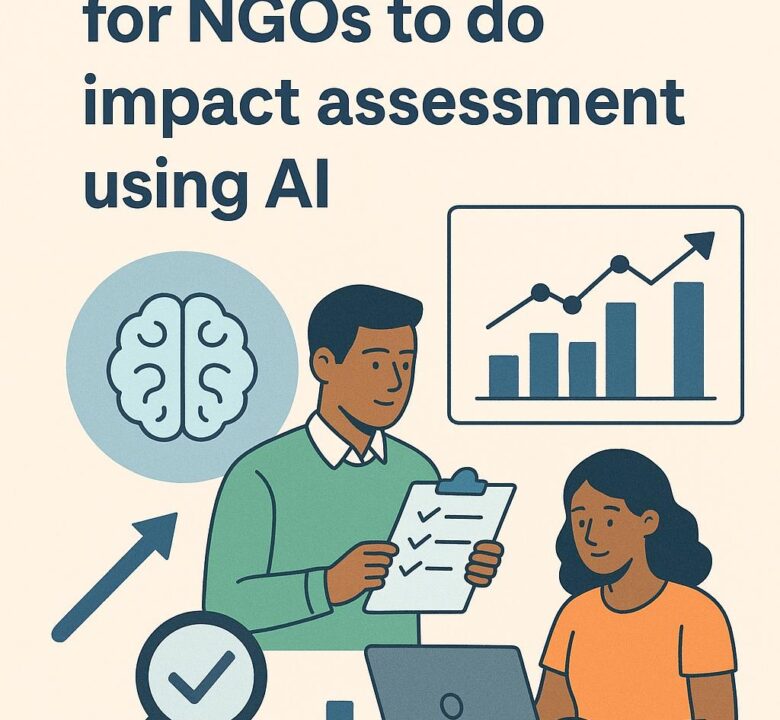
Use of AI in CSR – Skill Development
February 19, 2025
Why is it Important for NGOs to do impact assessment using AI
November 14, 2025In our last initiative, we successfully installed solar panels in 50+ government schools and primary health centers, providing green energy and off-grid power to these vital institutions.
Today, we will explore how AI can be leveraged to measure the impact of these solar installations in terms of Corporate Social Responsibility (CSR).
Measuring the impact of solar panels installed by a nonprofit requires data-driven metrics that showcase the environmental, social, and financial benefits.
AI is revolutionizing how nonprofits measure sustainability and climate project impact. By leveraging AI-powered data analysis, predictive modeling, and automation, nonprofits can enhance efficiency, transparency, and decision-making in their climate initiatives.
Here’s how we can collect and analyze proper data to prove the impact:
Key Metrics to Measure Solar Panel Impact
🔋 A. Energy Generation & Usage
Total Solar Energy Generated (kWh) – Track the electricity produced by the solar panels each month. To assess the annual impact, multiply the monthly generation by 12 months.
📊 How to Measure accurately:
Use smart meters & solar inverters (e.g., Genus Smart Meter which helps in IOT-based remote monitoring, L&T ER300P Smart Meter, and HPL Smart Solar Meter) to track energy production. Make a note of these readings on a regular basis and calculate the amount of electricity generated through solar panels.
Use of AI: Install IoT sensors to monitor real-time electricity generation.
Reduction in Grid Electricity Consumption (kWh) – Reflects the decrease in dependency on fossil fuel-based power. The reduction in fossil fuel usage can be estimated by calculating the amount of thermal fuel that would have been required to generate the equivalent electricity now supplied by the solar panels. This is particularly relevant as the installed locations primarily relied on thermal power plants for their electricity needs.
📊 How to Measure accurately:
How do Solar Panels Help?
By replacing 1 kWh of thermal power with solar energy, a nonprofit can prevent: ✅ 0.9 – 1.2 kg of CO₂ emissions (coal-based power)
✅ Significant reductions in SO₂, NOₓ, and particulate matter
✅ Lower fuel consumption and reduced dependence on fossil fuels
Use of AI: Please note that thermal plants can also use Natural Gas, Diesel, and HFO. We need to find out the primary source of electricity for the installed area and what is the source of energy used in thermal plant and then calculate the amount of emissions for each one of the components (like coal, diesel, natural gas, etc) using any AI powered software like ChatGPT
🌱 B. Environmental Impact (CO₂ Reduction & Sustainability)
Carbon Emissions Reduction (kg CO₂/year) – Shows how much pollution is avoided.
Equivalent Trees Planted 🌳 – Converts CO₂ savings into tree equivalents for easy understanding.
Air Pollution Reduction (SO₂, NOx, PM2.5) – Measures improvements in air quality.
📊 How to Measure:
Use emission factors from EPA’s Greenhouse Gas Equivalencies Calculator or Solar Carbon Offset Calculators.
Compare solar energy output with local grid emission intensity (kg CO₂/kWh) to estimate reductions.
Use of AI: Use AI software to calculate the number of reductions in carbon emissions and measure improvements in air quality. In the case of large-scale installation, we could also use tools like Google’s AI for Social Good to help track air quality in real-time using AI-powered satellite analytics.
💰 C. Financial Savings & Economic Benefits
Electricity Cost Savings ($/year) – Reduction in utility bills due to solar energy.
Lifetime Savings ($) – Estimated total savings over 20–25 years.
📊 How to Measure:
Compare electricity bills before and after solar installation.
Factor in net metering benefits (if applicable) from grid export. Currently, this is not applicable in India.
👨👩👧👦 D. Social & Community Impact
Number of Beneficiaries – Households or communities receiving clean energy. Record the number of students in the school or PHCs who are being benefited by these initiatives/
Improved Energy Access (%) – Increase in energy availability in underserved areas. This is very critical, particularly for Primary Health Centres where surgical procedures like deliveries are conducted.
Job Creation – Number of green jobs supported by installation/maintenance of the solar panels.
📊 How to Measure:
Conduct community surveys to assess satisfaction & energy access improvements.
Partner with local organizations to track job creation and skills training.
Impact Reporting: Presenting Data for Stakeholders
To prove the benefits of solar panels to donors, stakeholders, and policymakers, nonprofits should:
✅ Create Impact Dashboards – Use Google Data Studio, Power BI, or Tableau to visualize metrics.
✅ Issue Annual Reports – Include before-and-after comparisons of energy savings & CO₂ reduction.
✅ Use Storytelling & Case Studies – Highlight personal stories of communities benefiting from solar power.
Final Thoughts
To effectively measure and prove the impact of solar panel installations, nonprofits must track energy generation, CO₂ reduction, financial savings, and social benefits using IoT sensors, monitoring tools, and data visualization.
Would you like help selecting a specific tool for your nonprofit’s needs? 😊please feel free to connect in case you need support in this area.



